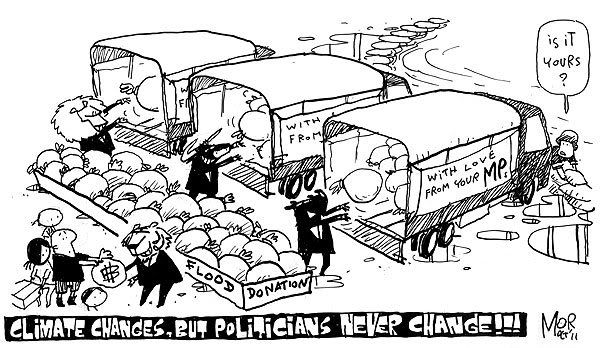“Behold I [God] will bring the waters of a great flood upon the earth, to destroy all flesh, wherein is the breath of life, under heaven. All things that are in the earth shall be consumed.”
– Genesis 6:16
That’s how floods happen, right? God gets angry. There’s a lot of rain. Flood happens. Well, not in Thailand. In fact, the rainfall last year was only marginally greater than usual. The catastrophic flooding was more caused by man’s greed than the hand of God.
The primary cause of the flooding was the mismanagement of water levels in major dams on rivers running south through the central plains. Water was held back so that fields downstream would remain dry so that rice farmers could make their third harvest of the year. This meant that the dams filled up to capacity and beyond. It was only mid-October when the massive Bhumibol dam was full to the brim. So when the rain kept coming, there was no option other than to let the water flow unconstrained down river.
What should have happened next is that excess water should have been redirected to low lying land – so-called “monkey cheeks”. However, much of this land is used for farming, and farmers don’t particularly like having their crops ruined. Influential people who depend upon farmers’ votes for their lucrative positions ensured that the sluice gates on their home turf remained firmly closed. It has been said that in Suphanburi province the MP personally holds all the sluice gate keys, and that not a single sluice gate was opened in his constituency.
So, farmers crops were spared – crops estimated to be worth about $95 million – at the cost of the devastation of seven major industrial estates – damage estimated at over $31 trillion – yes, trillion! And that’s not even counting the cost to the millions of people whose homes were flooded or small businesses ruined.
When the flood water reached Bangkok it was managed with what looks like ineptitude. But then the Flood Relief Operation Centre was manned by political cronies of the government, rather than by experts in water and disaster management. (They couldn’t even chose a dry spot for their offices, and were quickly flooded and had to be relocated.) Many mistakes were made in the opening and closing of sluice gates around Bangkok. And things weren’t made any better by angry residents forcibly opening gates so that their homes could be drained a little sooner at the expense of those living elsewhere.
Lack of building planning is another contributing factor. For example, before Suvarnabhumi airport was built the area acted as both a sponge (the original name for the area translates as “Cobra Swamp”) and a floodway to the sea. Now the water has nowhere to go. Industrial estates, housing estates and roads have all blocked the ways for water to drain.
Bangkok’s klongs have largely fallen into a state of disrepair. Local residents use them to dispose of their rubbish (and the stench from them can be unbearable) plus they are rarely dredged. To make matters worse, people have built homes at the sides of klongs, stealing part of the waterway and narrowing the klong. In at least one case an entire klong has “disappeared” after being filled in and built over.
***
So there it is, a sad litany of greed, selfishness and incompetence. Still, surely lessons have been learned, so this won’t happen again? Well, it seems not. The Bumibhol dam is still 91% full and experts are warning that this is far too high for this time of year, with the rainy season just around the corner. I guess I won’t be putting the waterwings away just yet.
[585]



























Recent Comments